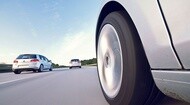
Learn
Can I use a high performance tire if my vehicle doesn't require one ?

- If you prefer a sportier look or feel to your drive, you may choose to upgrade your tires to “high-performance” tires with a higher speed rating.
- High performance tires are designed to give you higher speed.
- But to get that extra grip, you may give up some tread life.
*Exceeding the safe, legal speed limit is neither recommended nor endorsed.
Fuel consumption: how does upgrading impact it?

High-performance tires with higher speed-ratings are designed to provide more grip. By definition that means comparatively lower fuel efficiency than for standard tires since more grip often means more rolling resistance and more effort needed from the engine to move the car forward. However, thanks to our Michelin Total Performance philosophy, we strive to deliver both great handling and fuel efficiency in our high-performance tires.
I want a bigger tire size: what do I need to know?

What is it?
Some performance-minded drivers upgrade their original equipment wheels with wider, bigger wheels. It’s called tire upgrading or plus sizing
Why do it?
- It offers better handling when done properly
- It can make the vehicle look sportier
Two ways of doing it:
-
Plus 1, 2, etc.
The most popular form of plus sizing is increasing your vehicle’s wheel diameter and your tire’s rim diameter. An example is changing from a 14” wheel to a 15” wheel. This is called “plus 1.” (Going from 14” to 16” is plus 2, etc.) To make plus-sizing work, the tire’s aspect ratio decreases while the wheel diameter increases. (Note: The overall diameter of the tire never changes, just the wheel diameter.)
-
Plus Zero
If you want to leave your wheel diameter the same, you can still change to a wider tire. (Note: You may need a wider wheel as well.) An example is going from a P195/75R14 tire to P215/65R14 tire. What this means is that your tire width will be wider (195 millimeters to 215), your aspect ratio will be smaller (75 to 65) but the wheel diameter stays the same (14 and 14). Why do this? A wider contact patch on the road can mean better grip and handling.
What Is Staggering?
A staggered fitment is putting larger wheels on the back of your vehicle than those on the front of your vehicle. This specification comes from the vehicle’s manufacturer, and is designed to improve performance on vehicles with rear-wheel-drive.
Very Important Plus-Sizing Legal:
Michelin recommends checking with the vehicle manufacturer to identify any restrictions to an alternate tire size. Changes in the tire/wheel diameter can affect vehicle systems such as gearing, traction and stability control systems, braking and speedometer reading. Some manufacturers have already tested and approved multiple wheel diameters, so be sure to ask your authorized MICHELIN tire dealer on any sizing needs.







